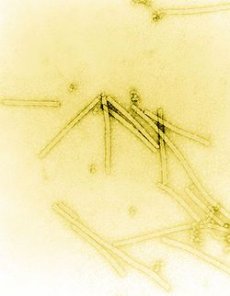The TT virus (TTV)
Last reviewed: 20.11.2021

All iLive content is medically reviewed or fact checked to ensure as much factual accuracy as possible.
We have strict sourcing guidelines and only link to reputable media sites, academic research institutions and, whenever possible, medically peer reviewed studies. Note that the numbers in parentheses ([1], [2], etc.) are clickable links to these studies.
If you feel that any of our content is inaccurate, out-of-date, or otherwise questionable, please select it and press Ctrl + Enter.

TT-virus derives its name from the first letters of English words denoting the method of transmission of this virus - transfusion-transmitted virus (TTV).
A new virus detected in patients (TT - initials of the patient) with posttransfusion hepatitis of unknown etiology was reported by Japanese researchers from the T. Nishizawa group in 1997, but not in the form of a virion, but as a fragment of its genomic single-stranded annular minus-DNA of size 2 , 6 kD. This virus was identified by PCR from the original clone N22 detected in the blood of a donor with increased ALT activity (106 U) and a high TTV DNA titer (10 5 / ml).
A virion with a diameter of 30-50 nm is devoid of a lipid shell, the capsid has a cubic type of symmetry. The DNA contains three open reading frames and an untranslated region containing many inverted repeats, through which intra-genomic rearrangements occur. More than 16 genotypes are differentiated. The virus was identified as the first representative of the new family Circinoviridae.
The TTV genome is represented by a non-shelled single-stranded ring-shaped DNA with a negative polarity of 3853 nucleotides. The similarity of the structure of this virus to the structure of parvoviruses was shown, 2 genetic groups with 30% difference in nucleotide sequences were divided into subgroups, differing by 11-15% of the difference in nucleotide sequences from each other. Thus, the subgroups Gla, G1b, G2a, G2b were singled out.
In-depth data on the decoding of the molecular and biophysical structure of TTV convince us of its similarity to the family Circoviridae (Springfeld C. Et al 2000).
Literally in the last few years there have been new data on the taxonomy of TTV. In accordance with the results of studies of several groups of authors, TTV is classified as a representative of the third group of the gene Anellovints (anelvovirus) and is called toro tenovirus (torque teno virus - TTV). Three aneliviruses (aneibviruses) are currently identified under the general name of "TT-virus": torque te by virus - TCO, torque teno mini virus - Torco genomicro virus (TTMV) and torque teno midi virus - Torko geno midi virus (TTMDV) (Ninomiya M. Et al, 2008). Test systems are created for differentiating the significance of these three anelloviruses for humans.
However, at present, the results of epidemiological and clinical studies are obtained without distinguishing the TT virus from three anelovirus.
Diagnosis is based on the detection of viral DNA by PCR. Viral infection among the population reaches 80% and is found in 15-30% of people with liver diseases.
The TT virus is able to multiply in hepatocytes, is transmitted by blood transfusion and by fecal-oral route. However, the question of whether a TT virus is a causative agent of hepatitis remains open; different versions are expressed. A group of SEN viruses (SENV) (SEN-A-SEN-H) also belongs to the possible pathogens of hepatitis. The SENV genome is a single-stranded linear DNA consisting of 3,800 nucleotides and has three variable open reading frames.
Viruses multiply in hepatocytes, are transmitted by blood transfusion. The SEN-D and SEN-H viruses are more often present in the blood of patients with hepatitis B and C.

